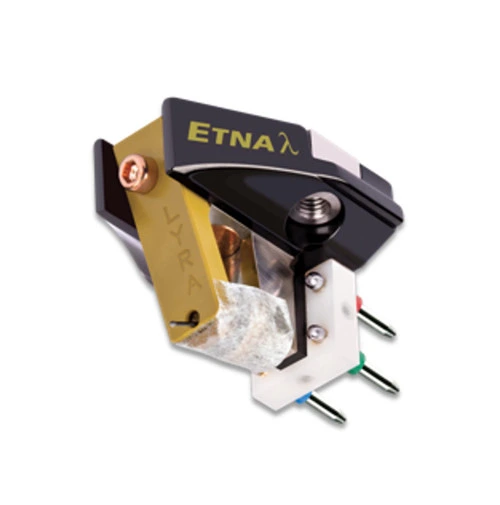Special Order Item, Built On Demand. Typically 2-3 Months (Can Take Longer).
| New (no trade-in) | $13,195.00 |
|---|---|
| Upgrade with trade-in of an Atlas, Olympos, Parnassusor Titan | $10,555.00 |
| Upgrade with trade-in of any other Lyra model | $10,715.00 |
| Retip/exchange | $6,745.00 |
This product can only be shipped to U.S. addresses.
The Atlas λ is Lyra's new flagship phono cartridge. Why asymmetric? By literally misplacing the "barriers" to great sound that are present in every other cartridge today, a number of important performance benefits are realized.
First, different-shaped structures on the left and right sides of the cartridge body suppress the formation of standing waves within, resulting in a significant reduction of resonance-induced colorations. Second, the asymmetric construction offsets the front magnet carrier and its associated mounting system so that it is no longer in line with the cantilever assembly. This opens up a direct, solid path between the cantilever assembly and tonearm headshell so that vibrations from the cantilever can be quickly drained away once they have been converted into electrical signals, again suppressing induced resonances.
Lyra remains the only cartridge manufacturer to mount the cantilever assembly directly into the cartridge body thereby achieving a seamless, totally rigid connection between the cantilever assembly and headshell. The effectiveness of this system has been enhanced as a result of the asymmetrical structure of the Atlas λ. Control over spurious resonances is further assisted by the use of a narrowed mounting area, which couples the Atlas λ more tightly to the headshell and facilitates the transfer of vibrational energy into the tonearm.
While the Atlas λ retains the yokeless dual magnet system, diamond-coated boron rod cantilever and variable-radius line-contact stylus of the Titan, the rigidity of the double knife-edge cantilever assembly mounting structure has been increased, and the signal coil system is completely new. Rather than a square, the coil former is in the shape of an X, which allows each channel to operate with greater independence from the other. This gives better tracking, tighter channel matching, improved separation, and lower distortion due to crosstalk.
At the same time Lyra was able to increase both the performance and efficiency of the generator coils. The Atlas λ has 12% higher output voltage than the Titan, but accomplishes this while reducing the amount of wire in the coils by 22%. This reduction in mass further improves tracking performance, while the enhanced output and electrical characteristics allow phono stages to perform more efficiently.
The Atlas λ uses Lyra's "New Angle" technology, which mechanically pre-biases the signal coils so that they are perfectly aligned to the front and rear magnets when LP playback takes place. This equalizes out discrepancies in vertical and horizontal compliances, and enables the Atlas λ coils to move with equal ease in all directions for optimal performance.
As with the Titan and Olympos, the hand-made Atlas λ uses a body that is meticulously carved from a solid billet of titanium, through a process that involves both contact (for the exterior) and non-contact machining (for the interior body structures). By making most of the Atlas λ body surfaces non-parallel (avoiding dimensions that are multiples of other dimensions), and adding a pre-stressed phase-interference resonance-controlling system, resonances have been further inhibited.
Lyra firmly believes that the Atlas λ represents an important step forward in LP playback.
When I substituted the Atlas λ Lambda for the older version in my Brinkmann La Grange turntable with Brinkmann 12.1 tonearm, the improvement in resolution and lucidity was instantly obvious....The original Atlas was famous for its world-beating dynamics and bass slam...The λ Lambda mixes in a little more beauty, not by softening the sound or adding an artificial sense of glow but by adding resolution, extracting and delivering more of the intrinsic beauty in the recording.
Technical Specifications
| Designer | Jonathan Carr |
|---|---|
| Builder | Yoshinori Mishima |
| Type | Medium weight, medium compliance, low-impedance moving coil cartridge |
| Stylus | Lyra-designed long-footprint variable-radius line-contact nude diamond (block dimensions 0.08w x 0.12d x 0.5h mm, profile dimensions 3um x 70um), slot-mounted |
| Cantilever system | Diamond-coated solid boron rod with short one-point wire suspension, directly mounted into cartridge body via high-pressure knife-edge system |
| Coils | 2-layer deep, 6N high-purity copper, cross-shaped chemically-purified high-purity iron former, 4.2ohm self-impedance, 11uH inductance |
| Output voltage | 0.56mV@5cm/sec., zero to peak, 45 degrees (CBS test record, other test records may alter results) |
| Frequency range | 10Hz ~ 50kHz |
| Channel separation | 35dB or better at 1kHz |
| Compliance | Approx. 12 x 10-6cm/dyne at 100Hz |
| Vertical tracking angle | 20 degrees |
| Cartridge body | One-piece machining from solid titanium billet, with reduced-surface higher-pressure headshell contact area, predominately non-parallel and asymmetrical shaping, phase-interference resonance-controlling mechanism, and body threaded directly for mounting screws |
| Cartridge mounting screws | 2.6mm 0.45 pitch JIS standard |
| Distance from mounting holes to stylus tip | 9.5mm |
| Cartridge weight (without stylus cover) | 11.6g |
| Recommended tracking force | 1.65 ~ 1.75g (1.72g recommended) |
| Recommended load directly into MC phono input | 104ohm ~ 887ohm (determine by listening, or follow detailed guidelines in user manual) |
| Recommended load via step-up transformer | 5 ~ 15ohm (step-up transformer's output must be connected to 10kohm ~ 47kohm MM-level RIAA input, preferably via short, low-capacitance cable) |
| Recommended tonearms | High-quality pivoted or linear (tangential) tonearms with rigid bearing(s), adjustable anti-skating force, preferably VTA adjustment |


 Turntable Accessories
Turntable Accessories Headphone Accessories
Headphone Accessories Cable Accessories
Cable Accessories Vinyl Accessories
Vinyl Accessories Compact Disc Accessories
Compact Disc Accessories









